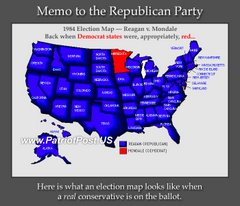Immigration-Legal and Otherwise (HT: Greg)
One thing that was different about these early immigrants was the fact they ASSIMILATED into their adopted country, the United States. They gave up their native languages for English; they fought in the wars as Americans; the flags they waved were American. They didn't ask for concessions and demand the United States accomodate them. THEY BECAME AMERICANS.
I have a few friends that are recently sworn in citizens as well. Their take on the "new breed" of immigrants? Well, let's just say I've seen my cats fight nicer. The new citizens are PROUD of America, PROUD to be AMERICAN, they have children serving in the Armed Forces and they have NO PATIENCE and NO SYMPATHY for those that come here illegally, those that refuse to assimilate into this country and demand accomodations for their needs rather than become full-fledged Americans. My hat is off to these new citizens who are excited to vote for the first time and who are in direct opposition to the illegals.
=============================================
Immigration has played an important role in American history, and the United States continues to have the most open immigration policy in the world. Before the era of rapid communications and transportation, America encouraged relatively open immigration to settle its empty lands. After certain states passed immigration laws following the Civil War, the Supreme Court in 1875 declared the regulation of immigration a federal responsibility. The Immigration Service was established in 1891 to deal with the big increase in immigration which started in 1880.
The outbreak of World War I reduced immigration from Europe, but mass immigration resumed upon the war's conclusion, and Congress responded with a new immigration policy: the national-origins quota system, passed in 1921 and revised in 1924. Immigration was limited by assigning each nationality a quota based on its representation in past U.S. census figures. Also in 1924, Congress created the U.S. Border Patrol within the Immigration Service.
There was very little immigration over the next 20 years, with net immigration actually dropping below zero for several years during the Depression. Immigration remained relatively low during the 20 years following World War II, because the 1920s national-origins system remained in place after Congress re-codified and combined all previous immigration and naturalization law into the Immigration and Nationality Act of 1952. American agriculture continued to import seasonal labor from Mexico, as they had during the war, under a 1951 formal agreement between the United States and Mexico that made the Bracero Program permanent.
In 1965, Congress replaced the national origins system with a preference system designed to unite immigrant families and attract skilled immigrants to the United States. This change to national policy responded to changes in the sources of immigration since 1924. The majority of applicants for immigration visas now came from Asia and Latin America rather than Europe. The preference system continued to limit the number of immigration visas available each year, however, and Congress still responded to refugees with special legislation. Not until the Refugee Act of 1980 did the United States have a general policy governing the admission of refugees.
Legal immigration alone in the 1990s likely matched or exceeded the previous historical peak decade of 1901-1910, when 8.8 million legal immigrants were admitted. Adding the settlement of illegal aliens makes the 1990s without doubt the period of greatest immigration in America's history.
Publications:
The Politics of Labor Scarcity: Expediency and the Birth of the Agricultural"Guestworkers" Program by Cindy HahamovitchCenter for Immigration Studies Backgrounder, December 1999
"Immigrant Indigestion": A. Philip Randolph, Radical and Restrictionist by Daryl Scott ((held the Center's 1998-99 Fellowship in Immigration Studies)Center for Immigration Studies Backgrounder, June 1999
"Cast Down Your Bucket Where You Are": Black Americans on Immigration by Robert MalloyCenter for Immigration Studies Paper No. 10, June 1996
Three Decades of Mass Immigration: The Legacy of the 1965 Immigration ActCenter for Immigration Studies Backgrounder, September 1995
Other links:
BCIS history page
Census Bureau paper on "Historical Census Statistics on the Foreign-born Population of the United States: 1850-1990" Sphere: Related Content










































